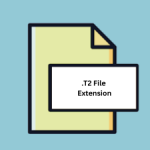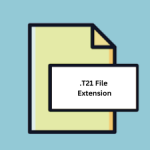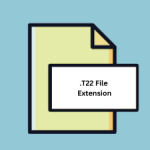.ESI File Extension

EtherCAT Slave Information
| Developer | EtherCAT Technology Group |
| Popularity | |
| Category | Data Files |
| Format | .ESI |
| Cross Platform | Update Soon |
What is an ESI file?
The ‘.ESI’ file extension represents the EtherCAT Slave Information file. These files serve as repositories of essential data about EtherCAT slaves within a network.
EtherCAT, short for Ethernet for Control Automation Technology, relies on a master-slave architecture, where the master device orchestrates communication with multiple slave devices in real time.
The ‘.ESI’ files contain detailed information about individual slave devices, enabling seamless integration into EtherCAT networks.
More Information.
The inception of EtherCAT aimed to address the limitations of traditional fieldbus systems, such as Profibus and CANopen, which struggled to meet the requirements of modern industrial automation.
EtherCAT’s innovative approach, leveraging a distributed clock mechanism and efficient data serialization, revolutionized the landscape of industrial communication.
The introduction of ‘.ESI’ files further simplified the setup and management of EtherCAT networks by providing standardized documentation for slave devices.
Origin Of This File.
The development of EtherCAT and its associated file format, ‘.ESI’, can be traced back to the early 2000s. EtherCAT was conceived by Beckhoff Automation, a German company specializing in industrial automation technology.
With the increasing demand for high-speed, deterministic communication in industrial environments, EtherCAT emerged as a solution offering superior performance and flexibility.
The ‘.ESI’ file format was introduced to streamline the configuration and integration of EtherCAT slave devices within networks.
File Structure Technical Specification.
The structure of ‘.ESI’ files adheres to a standardized format defined by the EtherCAT Technology Group (ETG).
These files typically consist of XML (Extensible Markup Language) or ESI (EtherCAT Slave Information) format, containing detailed descriptions of EtherCAT slave devices.
The technical specifications outlined in ‘.ESI’ files encompass various aspects of slave devices, including:
- Vendor information: Manufacturer name, product ID, and revision details.
- Device capabilities: Supported communication modes, data formats, and synchronization methods.
- Configuration parameters: Input/output mapping, process data sizes, and diagnostic information.
- Compatibility: EtherCAT device profiles and compliance with industry standards.
The hierarchical structure of ‘.ESI’ files enables efficient parsing and interpretation by EtherCAT master devices during network configuration and runtime operation.
How to Convert the File?
Converting ‘.ESI’ files may be necessary for compatibility with specific EtherCAT master devices or software tools.
While ‘.ESI’ files are typically provided by device manufacturers in standardized formats, conversion methods may vary depending on the target platform.
Common approaches for converting ‘.ESI’ files include:
- XML to ESI Conversion: If the ‘.ESI’ file is provided in XML format, specialized software tools or libraries can convert it into the native ESI format recognized by EtherCAT master devices.
- Vendor-Specific Tools: Some EtherCAT master devices offer proprietary software tools for importing and converting ‘.ESI’ files into a format compatible with their configuration interfaces.
- Manual Configuration: In cases where automated conversion is not feasible, manual configuration of EtherCAT master devices may involve referencing the information contained within ‘.ESI’ files during setup.
Before conversion, it is essential to verify the integrity and accuracy of the ‘.ESI’ files to prevent configuration errors and ensure seamless integration of EtherCAT slave devices into the network.
Advantages And Disadvantages.
Advantages:
- Standardization: ‘.ESI’ files adhere to standardized formats, promoting interoperability between different EtherCAT master devices and slave devices from various manufacturers.
- Simplified Configuration: The detailed information provided in ‘.ESI’ files streamlines the configuration process, reducing setup time and potential errors.
- Diagnostic Capabilities: EtherCAT master devices utilize ‘.ESI’ files to access diagnostic data and monitor the health and performance of slave devices in real time.
- Scalability: As EtherCAT networks expand, ‘.ESI’ files facilitate the seamless integration of additional slave devices without extensive manual configuration.
Disadvantages:
- Dependency on Vendor Support: The effectiveness of ‘.ESI’ files relies on comprehensive support from device manufacturers, including accurate and up-to-date documentation.
- Complexity of Interpretation: Understanding and parsing the information contained in ‘.ESI’ files may require expertise in EtherCAT technology and XML parsing, particularly for custom or proprietary device configurations.
- Limited Offline Functionality: ‘.ESI’ files primarily serve as reference documentation for EtherCAT master devices and are not intended for standalone offline configuration.
How to Open ESI?
Open In Windows
- Use text editors like Notepad++ or Visual Studio Code, which offer syntax highlighting and XML parsing capabilities.
- Alternatively, utilize specialized EtherCAT configuration software provided by EtherCAT master device vendors for comprehensive ‘.ESI’ file handling.
Open In Linux
- Linux users can employ native text editors like Vim or Emacs for viewing and editing ‘.ESI’ files.
- Additionally, command-line XML parsing utilities such as xmllint can be utilized for processing ‘.ESI’ files in terminal environments.
Open In MAC
- Text editors such as Atom or Sublime Text support XML parsing and are suitable for viewing and editing ‘.ESI’ files on macOS.
- EtherCAT configuration tools compatible with macOS may also facilitate the opening and manipulation of ‘.ESI’ files.













